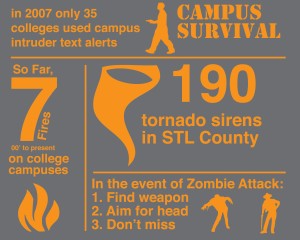Campus cameras are a start toward security but more is needed

In 1966, the University of Texas massacre occured and resulted in 16 deaths and 32 wounded. The Virginia Tech massacre of 2007 claimed 32 lives and wounded 25. How many lives would be lost and how many would sustain wounds if the same thing happened at STLCC-Meramec? How would students be notified ahead of time? Is security on campus sufficient for such an event?
Kirkwood as a whole is a pretty safe city. The last major violent crime in Kirkwood was the city hall shooting in 2008. As far as crime on the Meramec campus is concerned, there have been only three aggravated assaults, four burglaries and one non-forcible sex offense during the time between 2007 and 2009. While Kirkwood may not be a crime ridden area, that does not mean we as a campus are invincible.
First, take note of what the campus has done to provide better security for students and faculty. This semester they have added six new cameras on campus capable of identifying a license plate from across the parking lot. There are emergency call boxes placed at different locations throughout the campus that one can use to call for help. The call boxes alert campus security of a problem and they then send an officer to aid the student in distress. Campus police also patrol the area 24 hours a day keeping watch for suspicious activity.
One noticeable breach in security is that patrol on foot is sparse. So sparse in fact, that students are getting away with smoking despite the presence of a ban that has been in effect since January. They aren’t concerned about getting citations for smoking because there is no one around to give them. If they can get away with smoking, then what else can they get away with? The lack of foot patrol is something that should be addressed. There is an added risk of a crime taking place at night.
In addition to beefing up foot patrol, an increase in police car patrol would also be beneficial. There are some students who stay on campus late. If they get to their car with a dead battery and the security office has closed, they have to wait for an officer to come around.
Here is another possible scenario: there is an armed suspect walking onto campus from the west side, how would students coming in from the east side know about it? How would they find out about what is happening? If campus security were to implement a text or email notification system then everyone who is in the system would know that it is not safe and they should get inside until the suspect was apprehended. Even the students who are still at home would know not to come to class until it was safe.
Having some sort of alert system for suspicious behavior would also fix the lack of communication between security and the students they are keeping safe. As it stands now, security has a method of communication within itself. That means officers can communicate between each other and the security office. However, there needs to be a way that they can communicate important information to the students and faculty members. How can they know what to do or how to respond if no one is relaying the details of what is going on?
At the very least they could have an emergency response guide. STLCC-Florissant Valley has a PDF file on their website in the campus police section containing a guide as to what to do in a fire, tornado or chemical spill. It even tells students and staff what to do in a bomb threat or if shots are fired. Seeing as how Meramec is the biggest campus by number of students, there should be a response guide for this campus as well as STLCC-Forset Park.
Security at Meramec has gotten better and is in a relatively safe area. That said, crime can and does happen everywhere. It only takes one armed individual to take the life of a student or faculty member and disrupt the sense of safety we have grown accustomed to.
If you have comments or concerns please refer to the contact section online to submit a letter to the editor and for more information see story “Campus security increases surveillance” on page three.










